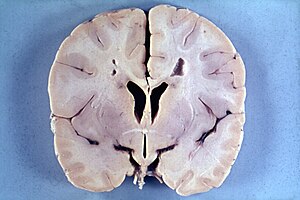Alexander disease
| Alexander disease | |
|---|---|
 |
|
| Brain of a 4-year-old boy with Alexander disease showing macroencephaly and periventricular leukomalacia (note brownish discoloration around the cerebral ventricles) | |
| Classification and external resources | |
| Specialty | endocrinology |
| ICD-10 | E75.2 |
| ICD-9-CM | 331.89 |
| OMIM | 203450 137780 137780 203450 |
| MeSH | D038261 |
| GeneReviews | |
| Orphanet | 58 |
Alexander disease, also known as fibrinoid leukodystrophy, is a progressive and fatal neurodegenerative disease. It is a rare genetic disorder and mostly affects infants and children, causing developmental delay and changes in physical characteristics.
Delays in development of some physical, psychological and behavioral skills; progressive enlargement of the head (macrocephaly), seizures, spasticity, and in some cases also hydrocephalus, idiopathic intracranial hypertension, and dementia.
Alexander disease is a genetic disorder affecting the midbrain and cerebellum of the central nervous system. It is caused by mutations in the gene for glial fibrillary acidic protein (GFAP) that maps to chromosome 17q21. It is inherited in an autosomal dominant manner, such that the child of a parent with the disease has a 50% chance of inheriting the condition, if the parent is heterozygotic. However, most cases arise de novo as the result of sporadic mutations.
Alexander disease belongs to leukodystrophies, a group of diseases that affect the growth or development of the myelin sheath. The destruction of white matter in the brain is accompanied by the formation of fibrous, eosinophilic deposits known as Rosenthal fibers. Rosenthal fibers appear not to be present in healthy people, but occur in specific diseases, like some forms of cancer. The Rosenthal fibers found in Alexander disease do not share the distribution or concentration of other diseases and disorders.
...
Wikipedia
